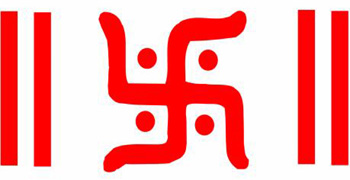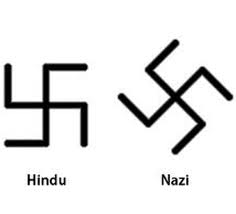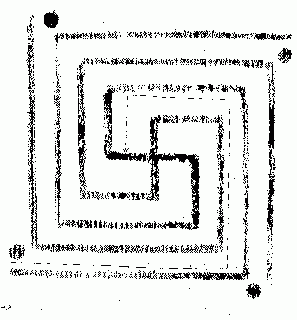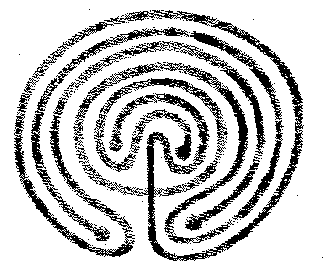VASTU SHASTRA
Swastika (Satya)

The Swastika
The next religious symbol which is also revered by Hindu and ranks second only to OM is the Swastika. Today, the Swastika is know the world over not as a religious symbolism of the Hindus but as the Nazi emblem. Hitler's use of the Swastika on the flag of National-socialist Germany has besmirched the Swastika. But the Swastika continues to hold a religious significance for the Hindus. Like OM, the origins of Swastika are lost in the misty realms of the past and they can only be guessed by piecing together of the surviving clues.
Unlike OM, the Swastika is not a syllable or a letter. It appears to be decorative charecter which could have originated in a hieroglyphic (pictorial) script.

The various ways in which the Swatika is depicted.
It is also revered by Hindu and ranks second only to OM is the Swastika. Today, the Swastika is know the world over not as a religious symbolism of the Hindus but as the Nazi emblem. Hitler's use of the Swastika on the flag of National-socialist Germany has besmirched the Swastika. But the Swastika continues to hold a religious significance for the Hindus. Like OM, the origins of Swastika are lost in the misty realms of the past and they can only be guessed by piecing together of the surviving clues.
The word Swastika is normally believed to be an amalgam of the words Su and Asati. Su means 'good' and Asati meant 'to exist'.
As per Sanskrit grammer the words Su and Asati when amalgamated into one word become Swasti (as in the case of Su and Aaatam becoming Swagatam meaning welcome). If this derivation of the word Swastika is true, then the literal meaning of the term Swastika would be 'let good-prevail'.
There exist many types of signs which stand for the Swastika. Even the standard version has two forms the one facing the right also called the symbol of- the right hand path and the one facing the left called the symbol of the lefthand path. These two Swastikas are also considered to represent the male and female. There is also a Swastika which is an amalgam of these two types.
All these forms present the Swastika to us as if it were only a symbol. But it is quite possible that Swastika was an object which played an important role in the real lives of people. Some scholars have said that in ancient times forst were builtin the shape of a grid resembling the Swastika, for defensive purposes. Under such an arrangement it was difficult for an enemy to storm into all parts of the fort simultaneously.
Did the Swastika originate as blueprint for a fort called Su Vastu?

In the conventional type of a fort, the fall of one of the gates to the attacking army would lead to the Enemy's pouring into the fort and lead to massacre or capture of all or most of its inhabitants. But under the Swastika grids fall of one of the four gates could still keep, at least three-fourths of the fort safe.
The understanding of the Swastika as a blueprint for a fort can also be etymologically corroborated. In Sanskrit, Vasa means to inhabit and Vastu means habitation. While Su means good. The word Swastika might be an amalgam of the terms 'Su' and 'Vastu' pronounced as as 'Swastu') meaning 'a good habitation'.
Incidentally in Sanskrit the term Swasta means calm or peaceful. Thus the term and concept of Swastika might as well be a derivation of the name of a defensive structure which due to its impregnable character was looked upon as a good habitation.
That this form of a defensive arrangement was a fact is also corroborated by the military practice of Chakra-vyuha used during ancient times. In the Chakra-vyuha, the army was arranged in the form of a circular grid which an enemy army was supposed to break. This was one of the techniques used during the Mahabharata war in which Arjuna's son Abhimanyu was killed. That the Chakra-vyuha was an effective form of defense and it was very diffciult to break it is corroborated by the episode of Abhimanyu in the Mahabharata. Briefly, this episode is as follows:

The clue that the Grid like the Swastika as a defensive arrangement was a fact is also corroborated by the military practice of Chakra-vyuha used during ancient times. In the Chakra-vyuha, the army was arranged in the form of a circular grid which an enemy army was supposed to break. This was one of the techniques used during the Mahabharata war in which Arjuna's son Abhimanyu was killed. That the Chakra-vyuha was an effective form of defense and it was very diffciult to break it is corroborated by the episode of Abhimanyu in the Mahabharata.
When Abhimanyu was on the family way, Sri Krishna used to take Subhadra (Abhimanyu's mother) on excursions. To humour her, Krishna used to relate many of his adventures to the pregnant Subhadra. On one such excursion Krishna was narrating his experience with the technique of Chakra-vyuha and how step by step the various circles could be penerated. It seems that Subhadra did not find this topic interesting enough for she soon went into a slumber. But someone else was interested in Sri Krishna's narration and that was the yet to be born Abhimanyu.
While Subhadra dozed off, Abhimanyu continued to carefully follow Sri Krishna's narrative of the Chakra-vyuha. But after talking for sometime and not receiving any response from Subhadra, Sri Krishna turned back and saw that Subhadra was savouring a sweet nap. Sri Krishna who had at that time come upto the seventh step of the Chakra-vyuha, gave up his narration and returned with Subhadra to the palace.
The unfortunate Abimanyu could never obtain the technique of breaking all the circles in the chakra-vyuha, but whatever he had heard Sri Krishna say, he carefully preserved in his memory. He grew up to be a brave handsome young man. Many years later when during the Mahabharata war the Kavravas set up a Chakar-vyuha and challenged the Pandavas to come forward and break it, none of the Pandavas knew the technique of doing so. At that Juncture to save the honour of the Pandavas, Abhimanyu came forward and offerred his services for the task of breaking the chakra-vyuha. Despite his incomplete knowledge of the technique he entered tne grid and overcame one circle after another till he come to the seventh one for the breaking of which he had no knowledge. Brave and ambitious es he was he fought valiantly in the unequal struggle but in vain. His strength and bravery proved no match against the skillfully laid out maze on warriors fighting whom, he met his end.
Similarly the Swastika could also have originated as a defensive structure which due to its vast practical utility was considered powerful and was sanctified.
Er. Rameshwar Prasad invites you to the Wonderful World of Vastu Shastra
Engineer Rameshwar Prasad(B.Tech., M.Tech., P.G.D.C.A., P.G.D.M.) Vaastu International
|

